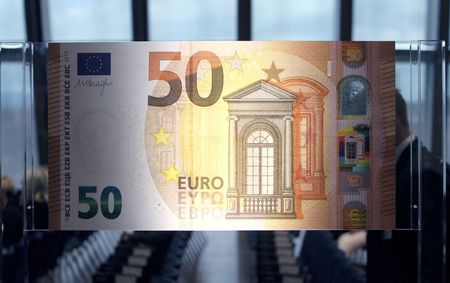By Samuel Indyk and Alun John
LONDON (Reuters) – Euro bulls might have to curb their enthusiasm after the rush to buy the single currency may have left it vulnerable in the short term, particularly given the uncertainty about many global central banks’ interest rate plans.
The euro hit its highest in 10 months against the dollar earlier this month, having gained 13% from late September’s 20-year low of $0.9528.
The prospect of a milder recession thanks to falling energy prices and plentiful supplies of natural gas, coupled with China finally emerging from three years of harsh COVID restrictions, have ignited investor appetite for European assets generally.
However, that enthusiasm has left the euro looking vulnerable, at least in the short term. The euro is set for a second straight week of declines and is currently around $1.075.
“I’m still positive on the euro, but if I look at our positioning data, it shows that current longs in euro, or what we call ‘current over-held positions’, reached a record high,” BNY Mellon EMEA strategist Geoffrey Yu said.
“The bar is extremely high for additional longs, or to add fresh euro exposure at current levels.”
Such extreme positioning in an asset is often seen as a negative, as it suggests there are comparatively few investors left to buy and plenty who could decide to sell.
Proprietary iFlow positioning data from the custodian bank showed its clients’ long euro positions against all other currencies (i.e. bets the euro will rise) are almost four times greater than the average position over the last 20 years, a record for the series.
Yu said some recovery was needed from September when “everyone was quite negative on the euro zone economy”, but “this is overpricing things”.
Underweight positions in euro were almost three and a half times their usual size in September, according to the data.
Rate Differentials https://fingfx.thomsonreuters.com/gfx/mkt/gkvlwdqngpb/Pasted%20image%201675959071342.png
The Commodity Futures Trading Commission’s Commitment of Traders report shows a similar picture. The latest data, for the week to Jan. 24, shows an increase in net long euro positions to $18.3 billion.
The euro’s gains have not just been at the expense of the dollar. Against the pound, it rose to its highest in over five months last week and hit a near 14-year high against the Swedish crown this week.
MOVING RATES
The euro got an extra boost versus the dollar as investors prepared for the possibility that the U.S. Federal Reserve would stop raising rates before the European Central Bank. The Fed is also expected to cut rates sooner than the ECB.
“As long as gas prices were such an important driver for the euro, then higher or lower interest rates didn’t matter. Now lower gas prices are allowing markets to look at interest rate differentials between Europe and the U.S.,” said Francesco Pesole, currency strategist at ING.
In theory, a currency that boasts higher interest rates tends to attract more investment than a lower-yielding one.
By early February, when the euro reached a 10-month high against the dollar, derivatives markets showed the smallest premium in dollar lending rates over euro rates since late 2021.
This premium widened out last week however, after very strong U.S. jobs data drove expectations the Fed has scope to raise interest rates further, causing the euro to retreat.
Medium term however, ING still thinks the Fed will cut rates aggressively in the second half of this year, and rate differentials will once again drive the euro/dollar pair. That, they say, will push the euro to around $1.15 by the end of the second quarter of 2023.
BNY Euro https://fingfx.thomsonreuters.com/gfx/mkt/movaklbekva/Pasted%20image%201675959708499.png
(Reporting by Samuel Indyk and Alun John, editing by Amanda Cooper and Nick Macfie)

